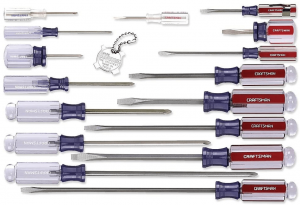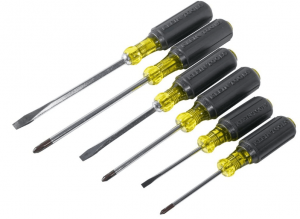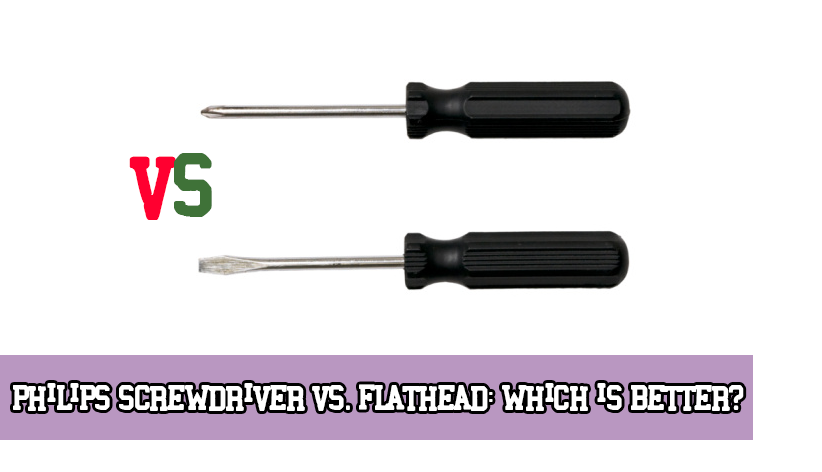* If you click a link on this page and make a purchase, we may receive a small commission at no extra cost to you. Learn more.
Your standard everyday screwdriver is a given in every toolbox. You can never find a home lacking those basic screwdrivers; from fixing cabinets in the kitchen to dealing with tiny screws on laptops, you will find a screwdriver for every size in every shape.
Throughout this article, we will explain the difference between two of the most famous screwdrivers; the Phillips and flathead, and why each one of them ought to be used only with its designated screws.
READ NEXT:
- Electric Screwdriver vs. Drill: Which is Better For Your Needs?
- Best Screwdriver for PC Building Guide
Table of Contents
Short Answer:
If you were dealing with a Phillips screw, then you need a Phillips screwdriver; however, if you are dealing with a slotted screw, then you will need your Flathead screwdriver.
What’s a Philips Screwdriver and How to Use it?
A Phillips screwdriver is used with a screw known as Crossword, meaning that it has two linear lines perpendicular to each other, forming the shape of a cross. This screw is mostly used in places that need high holding power but are not to be visible most of the time.
The only thing that you have to be very conscious about when using any type of screws, not just Philips, is that choosing the right size is key to success. The screwdriver must fit in snuggly with the notches on the screw; otherwise, it will strip the screws’ head, rendering it useless and stuck in the material.
Taking it out, later on, will require three times the effort and more tools than you initially needed. One last thing though, is that when dealing with a Phillips screw going into a metal that’s on the softer side such as brass, you have to be extra careful because you might over-torque it, causing the screw to strip or even break.
READ NEXT:
What’s A Flathead and How to Use It?
This screwdriver is wedge-shaped, and it’s used with a screw known as a slotted screw, which has one horizontal slot in the middle in-which the edge of the screwdriver will go. This screwdriver is by far the most common tool found in any toolbox or even junk drawer.
People have actually created new roles for a flat head other than screwing on slotted screws. Some people use it as a chisel, which must be done with care as you can easily break down the handle of the screwdriver rendering it completely useless. It can also be used as a scraper or even a paint can opener.
The only problem and the reason why slotted screws have been replaced by other screws such as Philips screws making flatheads less commonly used; is that the screwdriver tends to slip out of the linear notch a lot, which can waste a lot of valuable time.
On the bright side, though, if the wedge of flathead is narrow enough, you can actually use it in place of a Phillips screwdriver if the need arises. The opposite, however, is not true.
READ NEXT:
Philips Screwdriver vs. Flathead – Full Comparison
| Philips Screwdriver | Flathead | |
|---|---|---|
| Strength | Higher | Lower |
| Application Speed | Higher | Lower |
| Stripping Tendency | Lower | Higher |
| Versatility | Lower | Higher |
| Historical Appearance | No | Yes |
Now that we have discussed, generally, each screwdriver individually, we will show you our choices of the best Phillips and Flathead screwdrivers in the market today. The market for such products is exceptionally vast, and when purchasing such essentials, you’d certainly seek quality for something that would last you a lifetime.
The thing about screwdrivers is that nowadays, they are rarely purchased individually; the most common and economically friendly choice is to purchase a whole set of screwdrivers, which will come in handy on numerous occasions, so we will discuss the best two sets that we have found on the market.
1. Craftsman 9-31794 Overview

This 17 piece kit includes 9 Flatheads/slotted screwdrivers and 7 Phillips screwdrivers plus a 4 in 1 pocket. The handles are all made of butyrate for extra durability and strength with the blades themselves being heat treated. It is budget-friendly while giving you strength and endurance.
Pros:
- Heat-treated blades
- Butyrate Handles
Cons:
- May need more sizes
READ NEXT:
2. Klein Tools 85074 Overview

Although the small number of only six tools might be disappointing at first, do not forget that a historical American company such as Klein will never put out a product without knowing for sure that it will cover its users’ needs completely.
It has chosen the most commonly used sizes for each screwdriver giving you three slotted/flatheads And three Phillips screwdrivers. The screwdrivers are all honed to perfection, they will not slip, and they will not strip your screws. They are heat-treated, anti-corrosive, and will stay in your toolbox forever. The handles are ergonomic and very comfortable; no matter how oily or slippery your hand is, the screwdriver will never slip out.
One last thing is that in order for you to be more organized and more aware of where your tools are, the screwdrivers are labeled at the top so that you know what you’re working with and what is still in your toolbox.
Pros:
- Labeled handles
- Ergonomic Handle
- Heat-treated honed blades
Cons:
- Little variety
Final Thoughts
Screwdrivers come in all shapes and forms, each one designed to fit into a specific screw. Although you can tweak them a little bit to get the most out of your screwdriver, try not to overdo it as not to ruin your screw and therefore causing serious damage to your piece. Always try to use the correct screwdriver for each screw, regularly replace rusted screws, and try not to over to work them.

